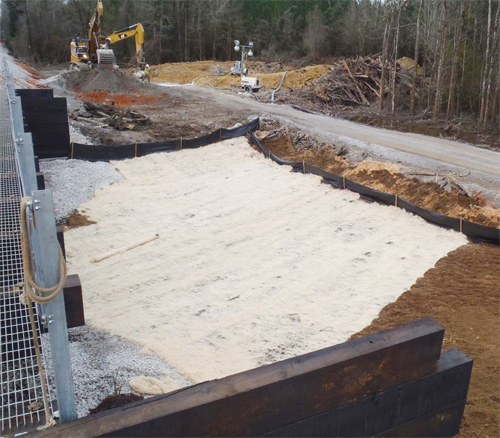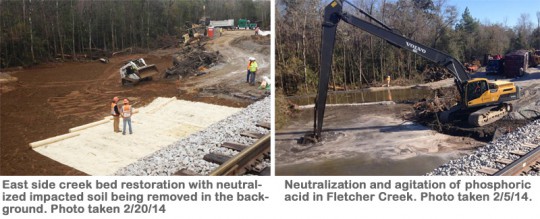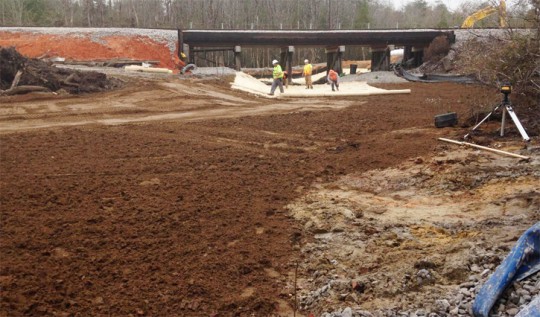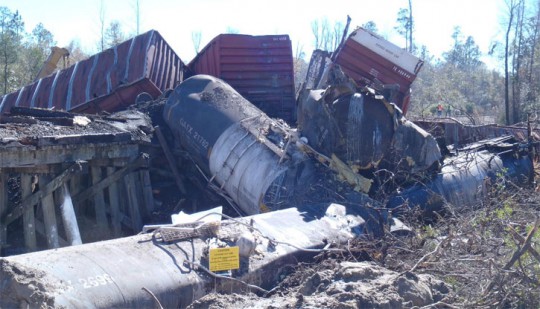Train Wreck Acid Spill Cleanup Continues With Long Term Testing Plans
February 24, 2014
Work is continuing today to clean up as much as 30,000 gallons of corrosive acid from a McDavid creek following a train derailment during a rare ice storm near McDavid, and plans are being made for long term water monitoring of Cotton Creek and the Escambia River.
At about 7:10 p.m. on January 28, 23 cars derailed off a bridge. Four cars containing 96 percent concentration phosphoric acid derailed into Fletcher Creek which feeds into Cotton Lake and the Escambia River. Three of the cars were breached, one catastrophically. Phosphoric acid is used in fertilizer production, pharmaceuticals, detergents, food products, beverages and other products.
 Workers at the site are currently conducting water quality monitoring at a total of 25 monitoring stations at the surface and lake bottom at Cotton Lake and the Escambia River. Water quality parameters being testing include pH (acid level), total phosphorus and dissolved oxygen.
Workers at the site are currently conducting water quality monitoring at a total of 25 monitoring stations at the surface and lake bottom at Cotton Lake and the Escambia River. Water quality parameters being testing include pH (acid level), total phosphorus and dissolved oxygen.
Beginning March 3, long term monitoring sampling will begin with long-term monitoring equipment to be installed.
All of the phosphoric acid contaminated water has been removed from Fletcher Creek, and restoration is underway on the dry creek bed.
Cleanup crews are continuing to transport liquid waste off-site. As of Saturday, 444,128 gallons of liquid waste had been generated, with 411,915 gallons shipped off-site. An additional 1,858 tons of sediment waste has also been removed.
Documents show 62,137 kilograms of elemental phosphorus mass was released at the site. Mass dissolved phosphorus weighing 2,934.99 kilograms was removed with 155,464 gallons of surface water.
Pictured inset: The west side restoration of Fletcher Creek. Pictured below: The creek bed restoration on the east side of the derailment site. Pictured bottom: The site in early February with multiple train cars derailed in the Fletcher Creek.
P
Comments
6 Responses to “Train Wreck Acid Spill Cleanup Continues With Long Term Testing Plans”






I agree, that the restoration will not be complete, unless they replace the native plants.
10,000 gallon tank/car X 3 cars = 30,000 gallons
At least those two statements are consistent
Is this location considered a wetland? I hope they are going to restore the original vegetation. A large disturbed area like that will just turn into a giant Chinese Privet patch if just left alone.
We the public deserve to know why we were told on Jan. 29th:
“After hours of close inspection, Escambia County crews have found no evidence of any chemical leaking from the derailed cars,” Escambia County PIO Bill Pearson said early Wednesday morning.”
Then the next day we are told of “a small leak”.
Then we are told of a 30,000 gallon leak.
Now we are told it was “Three of the cars were breached, one catastrophically.”
Someone has some explaining to do, especially our own Escambia County crews and Mr. Bill Pearson.
I am happy to see the response to the spill being so prompt and the efforts they are making to care for the environment. I have seen toxic spills in other parts of the country and the response was not prompt and the damage was permanent in some cases.
The cleanup looks good. Thanks for the update. Is the train track back open now ?